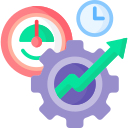Build Flow, Find Focus: A Home for Workflow Automation Software
Chosen theme: Workflow Automation Software. Welcome to a space where repetitive tasks fade into the background, teams move in sync, and your best work finally gets the spotlight it deserves. If this speaks to your day, subscribe and tell us which process you most want to automate next.

What Workflow Automation Software Really Solves
Automation turns scattered requests, emails, and pings into a predictable, trackable flow. A support team we coached replaced a messy inbox with automated triage, and response times halved within two weeks. Ready to try something similar? Tell us your current intake chaos.

What Workflow Automation Software Really Solves
Teams lose hours to low-value handoffs and status checks. With workflow automation software, approvals route themselves, reminders are precise, and updates happen instantly. A marketing lead regained five hours weekly by automating briefs. Want that time back? Subscribe for our pilot blueprint.

First Steps: Mapping and Prioritizing Your Processes
Walk the process end to end. Note every wait, rework, and decision. Ask frontline teammates where things stall and why. The best insights come from lived experience, not dashboards. Post your biggest choke point; we’ll suggest an automation pattern to test.
First Steps: Mapping and Prioritizing Your Processes
Choose a process that is frequent, stable, and visible. The ideal pilot is small enough to finish quickly but important enough to impress. Think onboarding requests, content approvals, or invoice matching. Share your shortlist, and we’ll help pick a winner.


Designing Smart Flows: Triggers, Logic, and Human Touch
Start a workflow when a form submits, a deal stage changes, or a threshold is met. Triggers should match business meaning, not technical convenience. If your trigger is vague, your outcomes will be too. Share your best trigger idea for feedback.
Designing Smart Flows: Triggers, Logic, and Human Touch
Use clear conditions that mirror policy: if contract value exceeds a limit, escalate; if risk is low, streamline. Name branches by intent, not cryptic codes. Keep logic readable for non-technical stakeholders. Post a branching scenario you struggle with and we’ll simplify it.



Measuring Impact: Metrics That Matter
Track the clock from request to completion, and from start to finish of each step. Shorter times mean faster value delivery. Plot distributions, not just averages, to spot variability. Post your current lead time and we’ll suggest a realistic reduction goal.
Measuring Impact: Metrics That Matter
Count defects caught, fields validated, and rework avoided. Automation should reduce mistakes without hiding them. Build feedback loops that surface issues early. Want a defect taxonomy to get started? Subscribe and we’ll send a lightweight template for consistent tracking.
Measuring Impact: Metrics That Matter
Design dashboards that answer real questions: where are items stuck, who needs help, what improved this week. Keep visual clutter low and refresh rates clear. Share a screenshot of your current view, and we’ll suggest quick tweaks for clarity and action.
Adoption and Culture: Making Automation Stick

Design for Trust
Explain what the workflow does, what it does not do, and how to opt out when needed. Publish a clear change log and invite feedback. Trust grows with transparency. Share your draft announcement copy and we’ll help make it reassuring and precise.

Citizen Developers, Real Governance
Empower power users with guardrails: templates, naming conventions, access controls, and review checkpoints. This balance unlocks speed without chaos. Celebrate wins in public channels to model good behavior. Curious about governance tiers? Ask and we’ll outline a pragmatic, lightweight framework.

Training That Feels Human
Offer short, scenario-based sessions that mirror real work. Replace dense manuals with checklists and two-minute clips. Schedule office hours for questions. If training delights, adoption follows. Tell us a scenario to cover, and we’ll craft a concise, clickable walkthrough for you.
What’s Next: AI, Process Mining, and the Road Ahead
AI That Explains Itself
Prefer AI that recommends next steps with reasons, not magic. Explanations build confidence and speed adoption. Use confidence scores and human overrides for sensitive cases. Share where you’d want AI suggestions, and we’ll sketch a safe, explainable approach for your team.
Process Mining as Your Map
Process mining visualizes how work actually flows based on event data, revealing bottlenecks you did not expect. Combine discoveries with targeted automation changes. Curious about data sources? Post your systems, and we’ll outline a starter mining pipeline for insights.
Sustainable Automation
Design for maintainability: modular workflows, clear ownership, and versioning. Small, elegant automations age better than sprawling, brittle monsters. Build a habit of quarterly reviews. Tell us your maintenance headaches, and we’ll propose a sustainability checklist tailored to your workflow landscape.
